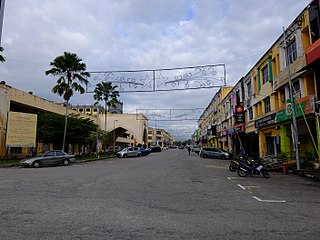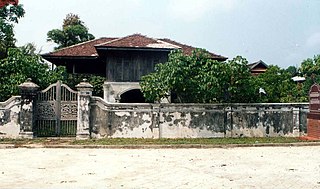
Pulau Duyong (Duyong Island) is a river island in the mouth of Terengganu River in the state of Terengganu, Malaysia.

Pulau Duyong (Duyong Island) is a river island in the mouth of Terengganu River in the state of Terengganu, Malaysia.
The former name of this river island was Pulau Peria, peria being the Malay word that means 'bittergourd', alluding to the shape of the island. The name was changed to Duyong, a Malay word that means 'mermaid', after the residents of the island were allegedly reported to see two mermaids landing on its shore. [1]

Pulau Duyong is located in Kuala Terengganu, and was previously divided into Pulau Duyong Besar and the smaller Pulau Duyong Kecil dan Pulau Ketam. Nevertheless, sedimentation and reclamation have united it as well as changed its coastline substantially. The area of the island now is 2.7 square kilometers. A seaward extension has been developed into the Heritage Bay Resort (now Duyong Marina & Resort) which previously hosted the annual Monsoon Cup yacht race. [2] This island is connected to Kuala Terengganu and Kuala Nerus via Sultan Mahmud Bridge. [3]
Pulau Duyong used to be the residence of scholar Tok Syeikh Duyong [4] (1802–1889), who was respected by the palace as well as the people, and his descendants, and was a seat of religious learning. The Kota Lama Duyong (Duyong Old Fort) [5] is a remnant of his era. Duyong Old Fort is an old Malay palace featuring a unique architecture influenced by Western and Egyptian Islamic elements. Due to its geographical shape and the locational significance in terms of religious scholarship, Pulau Duyong has been referred to as the tongue of Terengganu. [6]
Duyong Island is also known for its traditional boatmaking and boat repairing industry, which has existed since before independence. These traditional boats are made without the use of nails. [7] In its heyday, the boatmakers of Duyong Island received orders from a number of countries, although this industry is now declining. [3] [8]

Terengganu, formerly spelled Trengganu or Tringganu, is a sultanate and constitutive state of federal Malaysia. The state is also known by its Arabic honorific, Dāru l-Īmān. The coastal city of Kuala Terengganu, which stands at the mouth of the broad Terengganu River, is both the state and royal capital as well as the largest city in Terengganu. There are many islands located close to the coast of Terengganu state, such as Perhentian Islands and Redang Island.

Kota Bharu colloquially referred to as KB, is a town in Malaysia that serves as the state capital and royal seat of Kelantan. It is situated in the northeastern part of Peninsular Malaysia and lies near the mouth of the Kelantan River.

Kuala Terengganu, colloquially referred to as KT, is the administrative, economic and royal capital of the state of Terengganu, Malaysia. Kuala Terengganu is also the capital of Kuala Terengganu District. It is also the only royal capital among the nine royal states of the country to bear its state's name. Kuala Terengganu is located about 440 kilometres northeast of Kuala Lumpur on the East Coast of Peninsular Malaysia. The city is situated at the estuary of Terengganu River, facing the South China Sea.

The Perhentian Islands are islands in Besut District, Terengganu, Malaysia.

Redang Island is an island in Kuala Nerus District, Terengganu, Malaysia. It is one of the largest islands off the east coast of Peninsular Malaysia and as well as one of the most beautiful islands in the world. It is famous for its crystal clear waters and white sandy beaches. It is one of nine islands, which form a marine sanctuary park offering snorkeling and diving opportunities for tourists.

Lang Tengah Island is an island in Kuala Nerus District, Terengganu, Malaysia. It is connected to the mainland by ferries to Merang.

The National Museum is a museum located in Jalan Damansara, in Kuala Lumpur, Malaysia. The museum is situated in close proximity to the Perdana Lake Gardens and it provides an overview of Malaysian history and culture. Its facade comprises elements from both traditional Malay and modern features. It was inaugurated on 31 August 1963, and it serves as a repository of Malaysia's cultural and historical heritage.

Malay houses refer to the vernacular dwellings of the Malays, an ethno-linguistic group inhabiting Sumatra, coastal Borneo and the Malay Peninsula.

Mersing is a town, mukim and the capital of Mersing District, Johor, Malaysia.

Chukai, also known by the name of Kemaman Town is a mukim and capital of Kemaman District, Terengganu, Malaysia.

Besut is a district in Terengganu, Malaysia. It is bordered by the state of Kelantan to the north and west and the South China Sea to the east. It is the northern gateway to Terengganu. Kampung Raja is the district capital, though Jerteh is more developed. Another major town is the fishing port of Kuala Besut. There are other small towns and villages such as Jabi, Apal, Pasir Akar and Tembila.

Naga Pelangi is a wooden junk rigged schooner of the Malay pinas type built using traditional lashed-lug techniques from 2004 to 2009 in Kuala Terengganu, Malaysia. Finished in 2010, it is operated as a charter vessel in South East Asia.

The pinas, sometimes called "pinis" as well, is a type of schooner of the east coast of the Malay peninsula, built in the Terengganu area. This kind of vessel was built of Chengal wood by the Malays since the 19th century and roamed the South China Sea and adjacent oceans as one of the two types of traditional sailing vessels the late Malay maritime culture has developed: The bedar and the pinas.

The term bedar,, is applied to a wide variety of boats of the east coast of Malaysia that carry one or two junk sails and lack the typical transom stern of the perahu pinas. These junk rigged boats are usually built in the Terengganu area. The stern of the bedar is a classical "canu" or "pinky stern," being a typical "double ender", a bit like a modern ship's lifeboat, with a very full turn of the bilge and with markedly raked stem and stern. They came in small versions as small one-masted fishing vessels — anak bedar and were built as big as 90 feet over deck (LOD). The majority of the bedars were usually 45 to 60 feet over deck. The bedar, like all Terengganu boats, was built of Chengal wood by the Malays since the 19th century and roamed the South China Sea and adjacent oceans as a highly seaworthy traditional sailing vessel.
Tourism in Terengganu deals with attractions, events and facilities in Terengganu, Malaysia of special interest to tourists.

Kuala Nerus is a district in Terengganu, Malaysia. It is the youngest district in the state, having been declared a separate district in 2014. Formerly it was part of Kuala Terengganu district but the district is still governed by Kuala Terengganu City Council (MBKT) which is one of few city councils in Malaysia to govern two separate districts. Its capital is Kuala Nerus town, other major towns and villages include Gong Badak, Seberang Takir, Batu Rakit and Batu Enam, all which are located within city limits of Kuala Terengganu. Kuala Nerus' population is 226,177 people as of 2015 which makes it the most populous district in Terengganu. The district has a total land area of 397.52 km2.

The Kingdom of Besut Darul Iman was a historical Malay Kingdom located in the northeastern coast of the Malay Peninsula, precursor of the present-day Besut District and most of Setiu, Terengganu. A principality of Terengganu, the state was established in 1780 following the crowning of a Terengganuan prince, Tengku Kadir as the Raja Palembang Besut. The House of Palembang, a cadet branch of Terengganu nobility continued to rule the territory before it was unified with Terengganu in 1899.

Kuala Terengganu Drawbridge is a bascule bridge in Kuala Terengganu, Terengganu, Malaysia, which crosses the mouth of Terengganu River. The bridge is the fourth bridge in Kuala Terengganu City area that straddles the river after Sultan Mahmud Bridge, Manir Bridge, and Pulau Sekati Bridge.

Duyong Old Fort is a historical traditional house located in Duyong Island, which is about 7 km (4.3 mi) from downtown Kuala Terengganu, Terengganu, Malaysia. The Kota Lama Duyong house is described as a “fort” or Kota in Malay simply because it was surrounded by sturdy high brick walls.